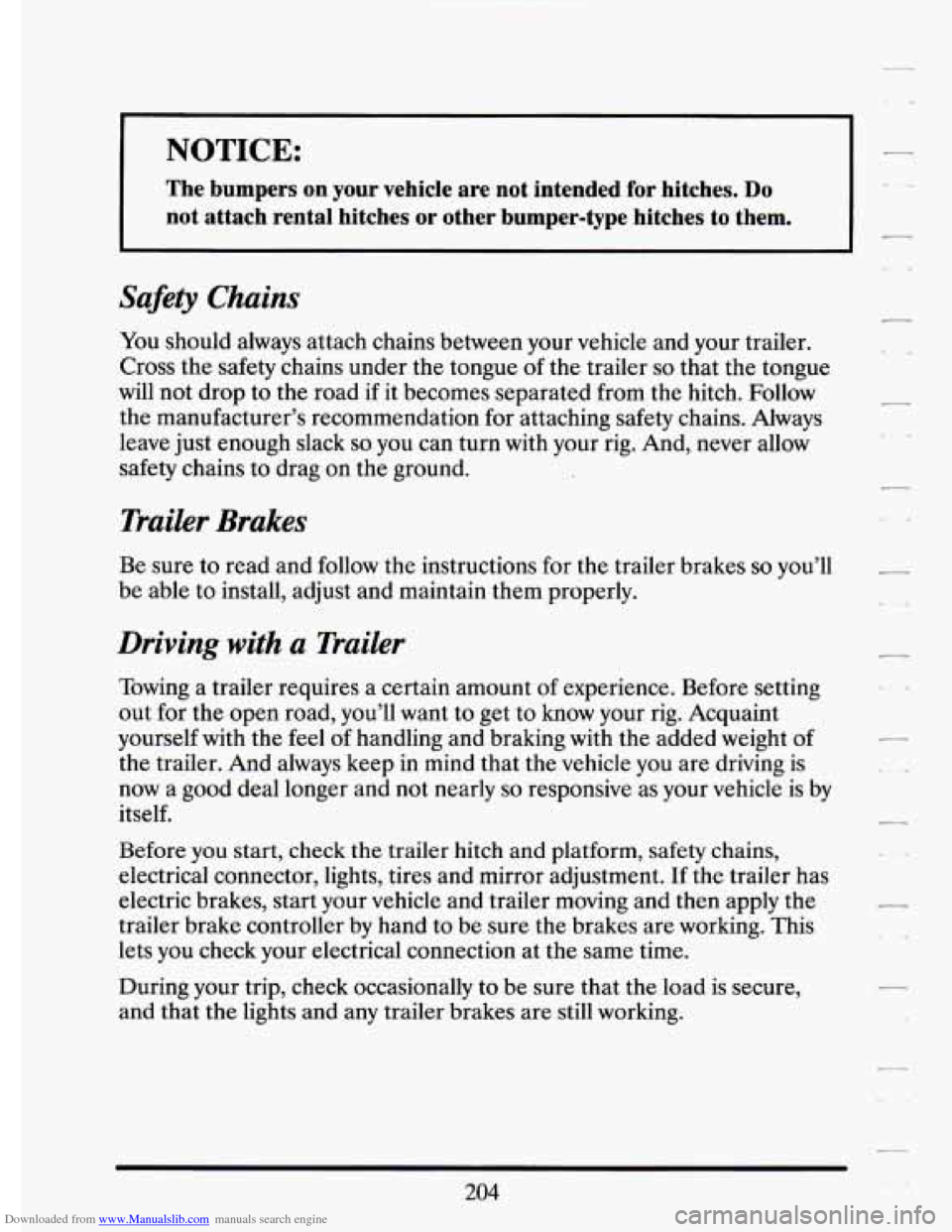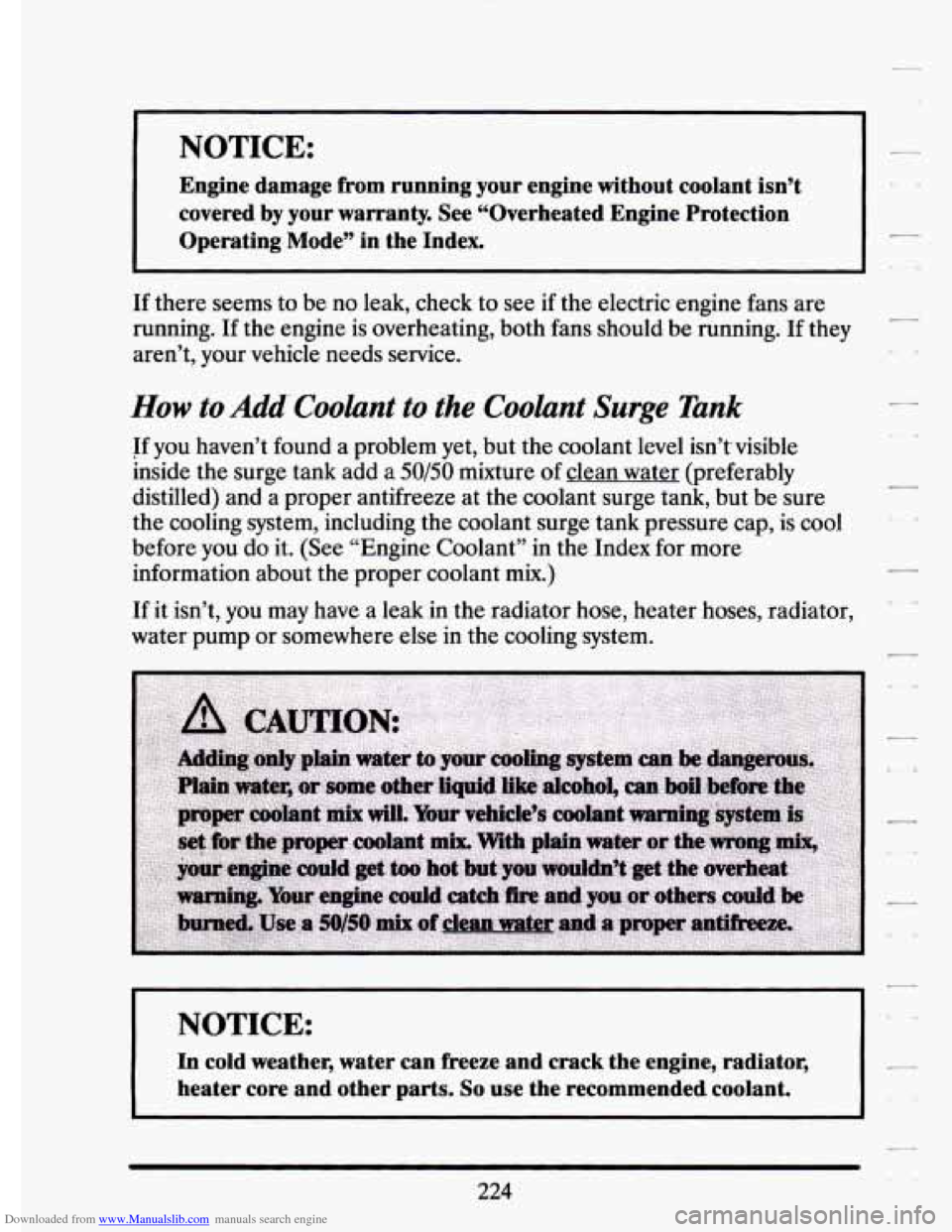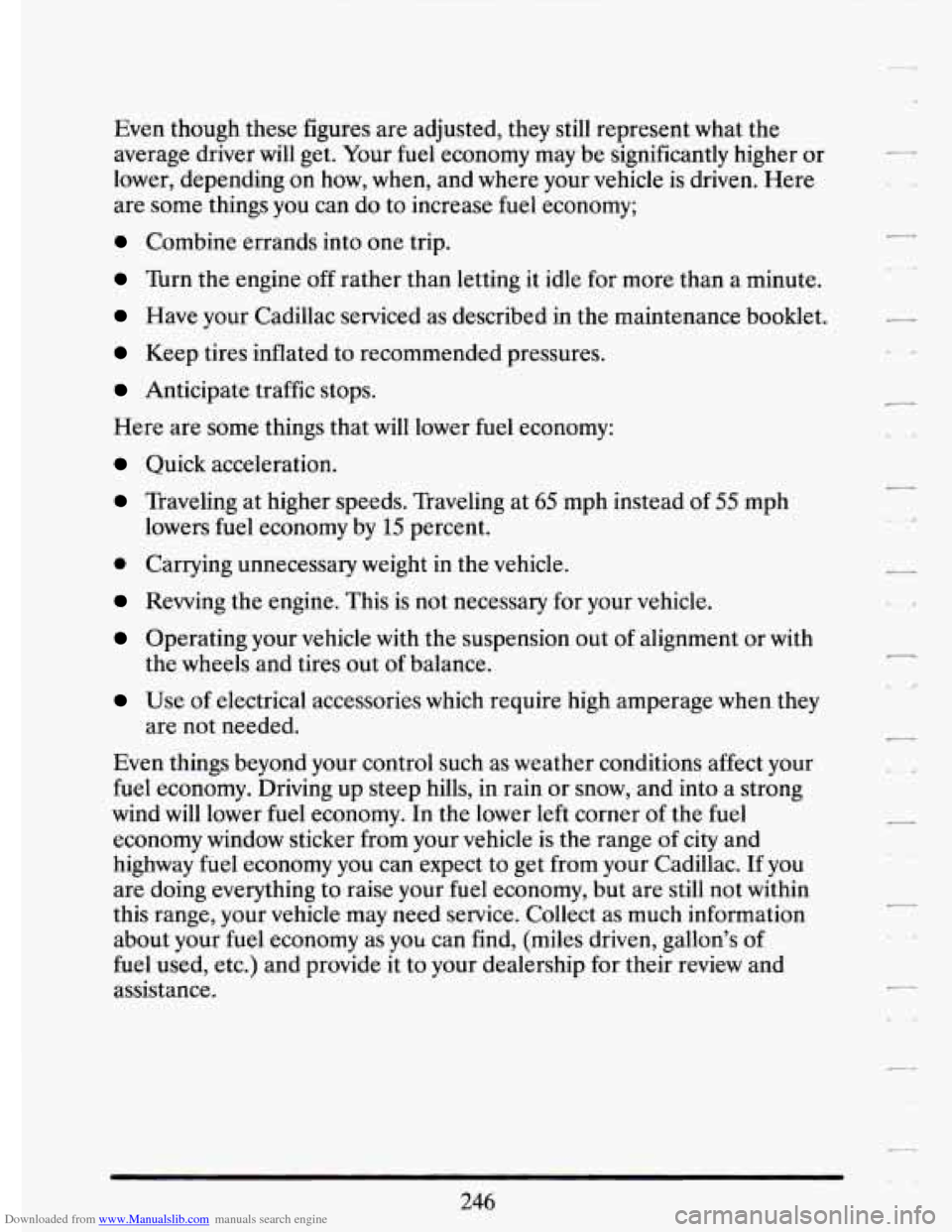Page 168 of 398
Downloaded from www.Manualslib.com manuals search engine Rear Seat Air Outlet
Move the switch to
adjust the blower
speed from
“LO” to
“HI.”
Move the “VENT”
lever to direct air flow
from either the upper
or floor outlets.
Heated Windshield (Option)
Front De-Ice
Here’s how to use your heated windshield in cold weather to remove ice
or frost quickly:
1. If any snow is piled up on the windshield, brush it away.
2. Start your Cadillac and leave it in P (“Park”).
3. Push the switch. A
light will come on
to tell you it
is
working.
Cr
4. Try not to use other electrical equipment while the system is working.
156
Page 216 of 398

Downloaded from www.Manualslib.com manuals search engine NOTICE:
The bumpers on your vehicle are not intended for hitches. Do
not attach rental hitches or other bumper-type hitches to them.\
-
Safety Chains
You should always attach chains between your vehicle and your trailer.
Cross the safety chains under the tongue of the trailer
so that the tongue
will not drop to the road
if it becomes separated from the hitch. Follow
the manufacturer’s recommendation for attaching safety chains. Alwa\
ys
leave
just enough slack so you can turn with your rig. And, never allow
safety chains to drag on
the ground.
Trailer Brakes
Be sure to read and follow the instructions for the trailer brakes so you’ll -
be able to install, adjust and maintain them properly. L:
Driving with a Trailer
Towing a trailer requires a certain amount of experience. Before setting
out for the open road, you’ll want to get to know your rig. Acquaint
yourself with the feel of handling and braking with the added weight of
the trailer. And always keep in mind that the vehicle you are driving is
now a good deal longer and not nearly
so responsive as your vehicle is by
itself.
Before you start, check the trailer hitch and platform, safety chains,
electrical connector, lights, tires and mirror adjustment. If the trailer has
electric brakes, start your vehicle and trailer moving and then apply the
trailer brake controller by hand to be sure the brakes are working. This
lets you check your electrical connection at the same time.
During your trip, check occasionally to be sure that the load is secure,
and that the lights and any trailer brakes are still working.
204
Page 224 of 398
Downloaded from www.Manualslib.com manuals search engine 2. Get the vehicles close enough so the jumper cables can reach, but be
sure the vehicles aren’t touching each other.
If they are, it could cause
a ground connection you don’t want. You wouldn’t be able to start
your Cadillac, and the bad grounding could damage the electrical
systems.
3. Turn off the ignition on both vehicles. Turn off all lights that aren’t
needed, and radios. This will avoid sparks and help save both
batteries. And
it could save your radio!
I NOTICE:
I
If you leave your radio on, it could be badly damaged. The
repairs wouldn’t be covered by your warranty.
4. Open the hoods and locate the batteries.
Find the positive
(+) and negative (-) terminals on each battery.
212
Page 227 of 398
Downloaded from www.Manualslib.com manuals search engine r
r.
r
r
r I. _I
r.
r
10. Don’t let the other .end touch anything until the next step. The other
end
of thenegative, cable doesn’t go to the .dead.battery. It goes to a
heavy unpainted metalpart on the engine
of .the vehicle with the dead
battery.
Attach the cable at least
18 inches (45 cm) away from the dead
battery, but not near engine.parts that-move. The electrical connection
isjust -as good there,-but the chance
of sparks getting back to the
battery is much less.
11. Now start the vehicle with the good battery and run the engine for
.12. Try to start the vehicle with the dead battery.
awhile.
Page 228 of 398
Downloaded from www.Manualslib.com manuals search engine If it won’t start after a few tries, it probably needs service.
13. Remove the cables in reverse order to prevent electrical shorting.
Take care that they don’t touch each other
or any other metal.
216
-.
c_
L
Page 234 of 398
Downloaded from www.Manualslib.com manuals search engine 2. Turn on your heater to full hot at the highest fan speed and open the
window as necessary.
3. Dial temperature control to the highest heat setting and open the
window, as necessary.
If you no longer have the overheat warning, you can drive. Just to be safe,
drive slower for about ten minutes.
If the warning doesn't come back on,
you can drive normally.
If the warning continues, pull over, stop, and park your vehicle right\
away.
If there's still no sign of steam, you can idle the engine for two or three
minutes while you're parked, to see
if the warning stops. But then, if you
still have the warning, TURN
OFF THE ENGINE AND GET
EVERYONE
OUT OF THE VEHICLE until it cools down.
You may decide not to lift the hood but to get service help right away.
COOLING SYSTEM
When you decide it's safe to lift the hood, here's what you'll see:
A. Coolant surge tank with pressure cap
B. Electric engine fans
222
c-
--a
Page 236 of 398

Downloaded from www.Manualslib.com manuals search engine I NOTICE:
Engine damage from running your engine without coolant isn’t \
covered
by your warranty. See “Overheated Engine Protection
Operating Mode” in the Index.
If there seems to be no leak, check to see if the electric engine fans are
running. If the engine is overheating, both fans should be running.
If they
aren’t, your vehicle needs service.
How to Add‘Coolant to the Coolant Surge Tank
If you haven’t found a problem yet, but the coolant level isn’tvisible
inside the surge tank add a
50/50 mixture of clean water (preferably
distilled) and a proper antifreeze at the coolant surge tank, but be sure
the cooling system, including the coolant surge tank pressure cap, is
cool
before you do it. (See “Engine Coolant’’ in the Index for more
information about the proper coolant mix.)
If it isn’t, you may have a leak in the radiator hose, heater hoses, radiator,
water pump or somewhere else in the cooling system.
c
NOTICE:
I
In cold weather, water can freeze and crack the engine, radiat\
or, -
heater core and other parts. So use the recommended coolant. L
_I
224
Page 258 of 398

Downloaded from www.Manualslib.com manuals search engine Even though these figures are adjusted, they still represent what the
average driver
will get. Your fuel economy may be significantly higher or
lower, depending
on how, when, and where your vehicle is driven. Here
are some things you can do to increase fuel economy;
Combine errands into one trip.
Turn the engine off rather than letting it idle for more than a minute.
Have your Cadillac serviced as described in the maintenance booklet.
Keep tires inflated to recommended pressures.
Anticipate traffic stops.
Here are some things that
will lower fuel economy:
Quick acceleration.
Traveling at higher speeds. Traveling at 65 mph instead of 55 mph
0 Carrying unnecessary weight in the vehicle.
Rewing the engine. This is not necessary for your vehicle.
lowers fuel economy
by 15 percent.
Operating your vehicle with the suspension out of alignment or with
the wheels and tires out of balance.
Use of electrical accessories which require high amperage when they
are not needed.
Even things beyond your control such as weather conditions affe\
ct your
fuel economy. Driving up steep hills, in rain or snow, and into a strong
wind will lower fuel economy. In the lower
left corner of the fuel
economy window sticker from your vehicle is the range
of city and
highway
fuel economy you can expect to get from your Cadillac. If you
are doing everything to raise your fuel economy, but are still not within
this range, your vehicle may need service. Collect as much information
about your
fuel economy as you can find, (miles driven, gallon's of
fuel used, etc.) and provide it to your dealership for their review and
assistance. LA